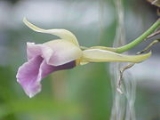
Cochleanthes
Encyclopedia
The genus
Cochleanthes is made up of fifteen species
of orchids which originate from South America
. The name Cochleanthes refers to the shape of the flower
(in Greek
, cochlos means "shell" and anthos means "flower").
This genus as a rule lacks pseudobulb
s and consequently produces tufted fan-like growths of fairly erect narrow leaves
, and conforms to the sympodial
method of growth.
Plants of this genus produce single-flowered inflorescence
s, with the flowers often being quite large for the size of the plant, and occurring at any time of the year, though slightly more concentrated during summer in cultivation. All members of this genus have their flowers dominated by the large labellum
(lip) which often has longitudinal markings upon it which serve as a nectar guide
for pollinating insect
s. The flowers have four pollinia.
Cochleanthes is best kept under intermediate conditions with fairly high humidity, and should never be allowed to dry out. Plants are epiphyte
s and grow at elevations of up to 1500 metres in cloud forest
s.
Genus
In biology, a genus is a low-level taxonomic rank used in the biological classification of living and fossil organisms, which is an example of definition by genus and differentia...
Cochleanthes is made up of fifteen species
Species
In biology, a species is one of the basic units of biological classification and a taxonomic rank. A species is often defined as a group of organisms capable of interbreeding and producing fertile offspring. While in many cases this definition is adequate, more precise or differing measures are...
of orchids which originate from South America
South America
South America is a continent situated in the Western Hemisphere, mostly in the Southern Hemisphere, with a relatively small portion in the Northern Hemisphere. The continent is also considered a subcontinent of the Americas. It is bordered on the west by the Pacific Ocean and on the north and east...
. The name Cochleanthes refers to the shape of the flower
Flower
A flower, sometimes known as a bloom or blossom, is the reproductive structure found in flowering plants . The biological function of a flower is to effect reproduction, usually by providing a mechanism for the union of sperm with eggs...
(in Greek
Greek language
Greek is an independent branch of the Indo-European family of languages. Native to the southern Balkans, it has the longest documented history of any Indo-European language, spanning 34 centuries of written records. Its writing system has been the Greek alphabet for the majority of its history;...
, cochlos means "shell" and anthos means "flower").
This genus as a rule lacks pseudobulb
Pseudobulb
The pseudobulb is a storage organ derived from the part of a stem between two leaf nodes.It applies to the orchid family , specifically certain groups of epiphytic orchids, and may be single or composed of several internodes with evergreen or deciduous leaves along its length.In some species, it is...
s and consequently produces tufted fan-like growths of fairly erect narrow leaves
Leaf
A leaf is an organ of a vascular plant, as defined in botanical terms, and in particular in plant morphology. Foliage is a mass noun that refers to leaves as a feature of plants....
, and conforms to the sympodial
Sympodial
Sympodial means "with conjoined feet", and in biology is often used to refer to the outward morphology or mode of growth of organisms.-In botany:...
method of growth.
Plants of this genus produce single-flowered inflorescence
Inflorescence
An inflorescence is a group or cluster of flowers arranged on a stem that is composed of a main branch or a complicated arrangement of branches. Strictly, it is the part of the shoot of seed plants where flowers are formed and which is accordingly modified...
s, with the flowers often being quite large for the size of the plant, and occurring at any time of the year, though slightly more concentrated during summer in cultivation. All members of this genus have their flowers dominated by the large labellum
Labellum
Labellum is the Latin diminutive of labium, meaning lip. These are anatomical terms used descriptively in biology, for example in Entomology and botany.-Botany:...
(lip) which often has longitudinal markings upon it which serve as a nectar guide
Nectar guide
Nectar guides are patterns seen in some species of flowers, guiding pollinators to their rewards. Rewards commonly take the form of nectar, pollen, or both, but various plants produce oil, resins, scents, or waxes...
for pollinating insect
Insect
Insects are a class of living creatures within the arthropods that have a chitinous exoskeleton, a three-part body , three pairs of jointed legs, compound eyes, and two antennae...
s. The flowers have four pollinia.
Cochleanthes is best kept under intermediate conditions with fairly high humidity, and should never be allowed to dry out. Plants are epiphyte
Epiphyte
An epiphyte is a plant that grows upon another plant non-parasitically or sometimes upon some other object , derives its moisture and nutrients from the air and rain and sometimes from debris accumulating around it, and is found in the temperate zone and in the...
s and grow at elevations of up to 1500 metres in cloud forest
Cloud forest
A cloud forest, also called a fog forest, is a generally tropical or subtropical evergreen montane moist forest characterized by a persistent, frequent or seasonal low-level cloud cover, usually at the canopy level. Cloud forests often exhibit an abundance of mosses covering the ground and...
s.
List of species
|
Cochleanthes marginata Cochleanthes marginata is a species of orchid.... |

